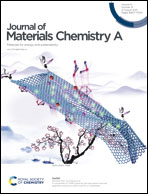An EPR investigation of defect structure and electron transfer mechanism in mixed-conductive LiBO2–V2O5 glasses†
Abstract
Continuous Wave (CW) Electron Paramagnetic Resonance (EPR) spectroscopy was used to study the defect structure and electron transfer mechanism in a series of LiBO2–V2O5 mixed conductive glasses of varying V2O5 content. These glassy materials are attracting growing interest for energy storage devices. At low V2O5 content (VLB1), an isolated S = ½ vanadium defect centre is found at a network modifying position within the LiBO2 matrix. The observed spin Hamiltonian parameters are consistent with a V4+ centre possessing a distorted octahedral configuration and dxy orbital ground state. At high V2O5 content (VLB3), the vanadium hyperfine structure is absent indicative of a distinct exchange-narrowed signal. A model was developed to analyse the linewidth and g-tensor component of the EPR signals, revealing a marked temperature dependent behaviour, consistent with a polaron hopping mechanism of electron transfer and inter-electronic exchange along the g3 direction, coincident with the electron transfer axis. The activation energy (Ea) was estimated to be 0.081 eV, consistent with other conducting glasses. A relaxation-dominated line broadening mechanism was further supported by multi-frequency EPR measurements, which also identified unresolved features at high frequencies due to unaccounted for anisotropic exchange/speciation within the disordered network. This analysis provides a straight-forward method for the use of EPR to investigate solid-state glassy materials.



 Please wait while we load your content...
Please wait while we load your content...